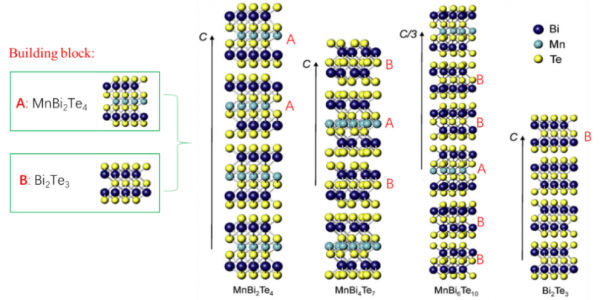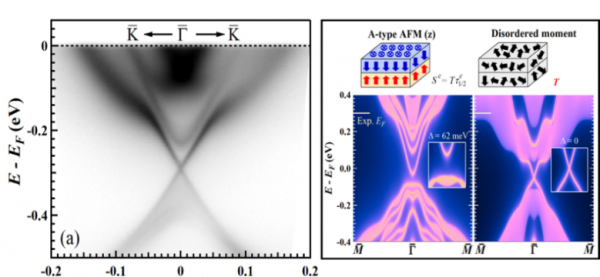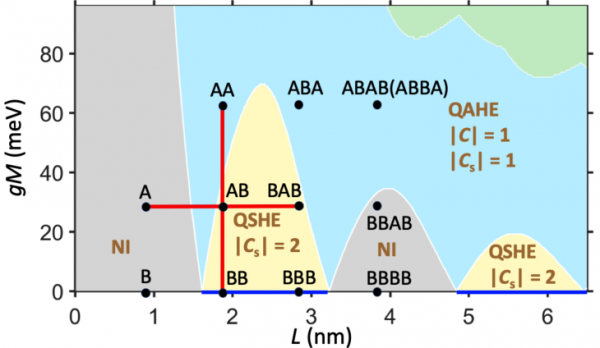Researchers make breakthrough in magnetic geometry-induced quantum geometry and nonlinear transport
2025-06-06SUSTech hosts IOP Forum with President of Institute of Physics Sir Keith Burnett
2025-03-26Researchers discover unusual thermal conductivity in high-symmetry single crystals
2025-03-26New efficient method detects quantum temporal correlations
2025-03-26Researchers explore unconventional magnons predicted by spin space groups
2025-03-25An international group of researchers has developed novel quantum materials suitable for next-generation electronic devices that are more efficient and provides enormous potential for future research.
Recently, Southern University of Science and Technology (SUSTech) Department of Physics Associate Professor Liu Qihang led his research team to join an international research project that made critical breakthroughs in magnetic topological materials. The most recent paper was published in Nature Communications (IF=12.19) under the title “A van der Waals antiferromagnetic topological insulator with weak interlayer magnetic coupling.” Other articles from the collaboration have been published in Physical Review Letters (9.23), Physical Review X (12.21) and Nano Letters (12.28)
The quantum anomalous Hall effect reflects a quantized Hall effect without a magnetic field. The materials used in these experiments are two-dimensional (2D) magnetic topological insulators that are known as Chern insulators. The critical characteristic of a magnetic topological insulator is that electrons travel around the edge of the insulator (through its edge state). These edge states contribute to quantization, are not very sensitive to local disorder and prevent electrons from being quickly scattered. As a result, these materials can be used to design low-power electronic devices such as transistors.
Studies have shown that Chern insulators can be obtained from magnetically doped topological insulator films. This method struggles to produce stable long-range ferromagnetic sequences with a high enough bulk energy gap. Prof. Liu Qihang’s group and collaborators studied the Mn-Bi-Te family and proposed a superlattice structure for magnetic topological insulators.

Figure 1: Mn-Bi-Te family
The use of the family of manganese (Mn), bismuth (Bi) and telluride (Te) compounds as a layered antiferromagnetic topological insulator is due to their properties that support magnetic topological insulators. The existing theory suggests that the natural surface of this type of topological insulator creates a sufficient energy gap caused by magnetism. The researches found that a topologically protected Dirac cone (an area with linear energy dispersion and highly conductive of electrons) appeared on the surface of the magnetic topological insulator. The presence of the topologically protected Dirac cone was unexpected, and theoretical calculations suggest that this may be the result of magnetic surface reconstruction from disorder. Prof. Liu’s team listed several potential areas to support this state in a paper published in Physical Review X (Figure 2).

Figure 2: Surface state of MnBi2Te4 [001] surface. (Left) A gapless Dirac cone observed by ARPES. (Right) The surface states corresponding to different magnetic configurations calculated theoretically.
Previous studies had suggested that the quantum anomalous Hall effect would occur in MnBi2Te4 in odd layers. However, subsequent layers did not clearly observe this effect due to the high magnetic field required. The quantum anomalous Hall effect needs to reduce or eliminate the need for an external magnetic field wherever possible. To deal with this, a MnBi4Te7 compound could effectively reduce electron exchange between adjacent layers by an order of magnitude compared to MnBi2Te4. They have subsequently found that MnBi4Te7 is an ideal quantum anomalous Hall effect material and worthy of further research. This research was published in Nature Communications.
Prof. Liu Qihang’s research group also found that a two-dimensional multilayer Mn-Bi-Te topological magnetic insulator can achieve different topological phases, including the quantum spin Hall effect with and without time-reversal symmetry, as well as the quantum anomalous Hall effect (Figure 3). The results of this research were published in Physical Review Letters.

Figure 3: Topological phase diagram and topological phase distribution of different two-dimensional Mn-Bi-Te configurations. The gray, yellow, and light blue regions are mediocre insulators, and the time-reversed quantum spin Hall state and quantum anomalous Hall state is broken; the blue line is time-reversed symmetric quantum spin Hall state.
The phase diagram shown in Figure 3 of the magnetic topological insulator suggests some oscillations between different topological states. Prof. Liu Qihang and his research group found that some specific topological oscillations exist in Bi2Te3 films, but not for Bi2Se3 films, contrasting from the previous Hamiltonian model. They studied the band structure of Bi2Se3 thin films and determined that the bandgap of this two-dimensional system is indeed topologically trivial. The results of this research were published in Nano Letters.
These papers indicate new directions for magnetic topological insulators and quantum anomalous Hall effect materials. It will almost certainly stimulate a significant amount of new theoretical and applied research in these two fields.
Associate Professor Liu Qihang is the corresponding author (co-corresponding author) of these articles. The main collaborators include SUSTech Department of Physics Associate Professor Xu Hu, Shenzhen Institute of Quantum Science and Engineering (SIQSE) Associate Researcher Chen Chaoyu, National University of Defense Technology (NUDT) Professor Wang Zhenyu, University of California Los Angeles (UCLA) Professor Ni Ni and University of Colorado Professor D. Dessau.
The development and completion of this project were supported by the National Natural Science Foundation of China, the Guangdong Provincial Innovation and Entrepreneurship Team, the Guangdong Provincial Key Laboratory, the Shenzhen Key Laboratory, and the Supercomputing Center of SUSTech.
Paper link:
Physical Review X, Surface Dirac cone of magnetic topological insulator MnBi2Te4: https://journals.aps.org/prx/abstract/10.1103/PhysRevX.9.041038
“Nature Communications,” Topological properties of magnetic topological insulator MnBi4Te7: https://www.nature.com/articles/s41467-019-13814-x
“Nano Letters,” Topological properties of topological insulator Bi2Se3 two-dimensional films: https://pubs.acs.org/doi/10.1021/acs.nanolett.9b01641
“Physical Review Letters,” design of quantum anomalous Hall effect based on layered magnetic topological insulator: https://journals.aps.org/prl/abstract/10.1103/PhysRevLett.123.096401
Homepage of Liu Qihang’s group: https://liuqh.phy.sustech.edu.cn/